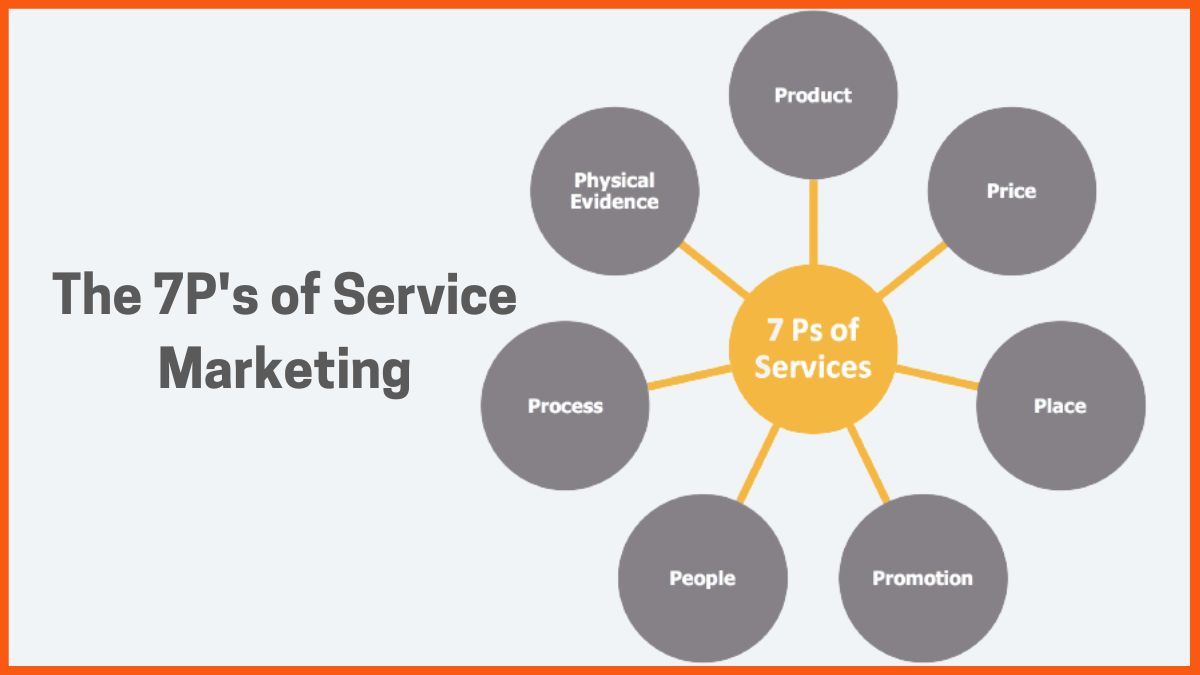An Ultimate Guide to Understanding the Service Marketing and Its Types
📖 Learning
Have you ever encountered facilities that have repeatedly saved the day? Take a look; you'll notice that you're surrounded by a variety of important services. You may be accessing this article via Wi-Fi.
Have you recently placed an order for sneakers for an event the following day? Did you ever transfer cash to a brother in another nation with just some Snaps? These are mostly a few of the key services. As a result of all this, I'd like to talk about what service marketing is and the intricacies that it encompasses.
What is Service Marketing?
Service Marketing Mix
The Paradigm of Service Marketing
The triangle - Types of Service Marketing
Common Strategies Used in Service Marketing
Perks of Service Marketing
Common Issues of Service Marketing
What is Service Marketing?
It pertains to the use of a variety of techniques to predict a customer's wants for an abstract item. As a result, it suits their needs to get the most out of their purchase. Marketing services differ from products. It's difficult to persuade customers to buy services and to price intangibles.
Service marketing emerged as a separate branch of marketing in 1980. The field basically consists of the unique characteristics of services combined with the strategies for marketing physical goods. Some of the most common examples of Service marketing are facilities provided by hotels, health services sold by doctors, nurses, and other hospital staff, etc.
Service Marketing mix

It is a collection of strategies used to incentivize clients to purchase services. An offshoot of the 7Ps of service marketing.
Product
Product plays the most crucial role in service marketing. It is the prime thing that an owner sells to their customers. It can be as simple as a hotel room with a bed. The prime difference between product marketing and service marketing is that the product itself stands for the service. The service that a firm would like to see. Since services are abstract, we can consider the item and the method to be assets.
Price
Prices can be very much similar to the competitors. But the prime focus with prices in service marketing is to keep up the service quality with similar charges as of others. Surprisingly, when it comes to services, clients tend to equate a premium cost with good quality. And they also prefer to have a complete comparison of the prices between the service they receive and the price needed to pay.
Place
Consumers' convenient access to a service. Basically, the place stands for the location where service is received. It also plays an essential role in determining the customer's review of the service. The best example to understand this is the saloon where customers go to receive their service.
Promotion
Promotion is equally essential to educate customers about the services. It can be in the form of television ads or verbal promotions done by customers. Promotions help customers understand services and provide an easy way to contact the company.
People
People who are participating in the service's transfer. Employees are most commonly used, but consultants and past clients may also be used. Service organizations have a special focus on their people in order to have beneficiary support there. This step is also somewhere related to internal marketing.
Physical evidence
The setting or location that surrounds the area where service is provided. Any measurable aspects that aid or notify the service. The importance of physical evidence is to primarily shape the mind of visiting customers. The best example of this can be taken up when a customer visits the bakery, the smell of freshly baked products is presented as evidence of the taste and freshness of their products.
Process
Processes, mechanisms, and activity flow happen when a client and a company engage and are all included in the process. The process is the step that is fully detailed and has all required steps formed together.
It all comes down to identifying the perfect mix of elements to render a service marketable. The middle point is defined as a spot at which all 7 strategies are in harmony. Assume we switch from a low-cost to a premium airline. We'd have to assess the cost and all of our other strategies.
More folks are needed to provide personalization, as this is what higher-end clients expect. We must alter our procedures so that each person gets more time and support.
Consider a high-end hotel for an example with their 7ps.
- Product: Hotel suites
- Price: Variable depending on indoor space.
- Place: Hotel venue, an app for butler service.
- Promotion: Advertisement on hotel-related booking sites. Personal selling.
- People: Managers, admin staff, and so on.
- Process: Room reservation, check-in and check-out, and so on.
- Physical evidence: Before and after your stay, you will receive excellent service. Blog.
The Paradigm of Service Marketing
Service classification:
It appears that service sectors are more tricky than industrial sectors. The services can be objective or subjective, focusing on folks or products. They are divided into four groups predicated on their applicability.
1. People Processing Services
It pertains to the client's physicality at the venue to receive services. The best example of this is the presence of a client at a saloon in order to get their hair styled.
2. Product/Possession Processing Services
These services are linked to a particular item or its ownership, with the client having little or no engagement. The best example to understand this is the recycling of waste, laundry work, repair, maintenance work, etc.
3. Mental Stimulus Processing Services
They are those that impact mental capabilities, perspective, and way of life. Prime examples of these are television shows, advertisements, radio shows, etc. For each of the customers, these services will be perceived differently whereas, on the other hand, there is no presence required of the customer at any certain place.
4. Information Processing Services (Data)
This is a distinct type of asset — in which data is used as an item or informatics. The best concept to understand this is the banking service where once the information is added to the computer, then the required process is wholly carried out by IT without the need for the presence of the customer. Some other examples to understand this can be computer programming, legal services, etc.
Customer-oriented Classification:
In the service sector, personalization is more important than in the industrial sector. When operating as a provider, the wants and perceptions of the clients are prioritized.
1. One-time action
It's a one-time action. Because it is abstract and irrevocable, it must be ideal and supplied correctly. A company needs knowledgeable and talented staff to offer services since a bad review can lead to adverse media exposure that harms the firm's image and equity.
2. Service as a process
The method is essential in the service sector. All the steps that a customer has to undergo in order to receive that facility must be well looked after by the organizations. The steps should also be rechecked and filled with a positive attitude in order to give an easy path to the customer till the final step.
3. Speed and Accuracy
Customers prefer uninterrupted service. As a result, the speed at which the service is offered is an important criterion overlooked by the customers while selecting a service. Majorly customers are in need of a speedy service with the utmost accuracy.
The triangle - Types of Service Marketing

It refers to the interaction between the supplier and the buyer. As we all understand, establishing relationships is critical to the success of any business. The triangle essentially explains this bond.
Internal marketing
Internal marketing works in the internal system of a firm in order to strengthen it. The training of the staff, staff appreciation for their good work, etc. are all included in this step. Strategic planning involving staff is a part of the internal marketing of a firm.
External marketing
It boosts brand visibility. Direct marketing tactics are used in this promotional strategy to lure more clients. The process that involves boosting brand visibility like reaching out to the target audience by means of advertisements, websites, social media platforms, etc is all included in external marketing.
Interactive marketing
It entails communication between workers and clients. Workers support clients with multiple purchases and answer their questions, and we can claim that they aid them in the buyer decision-making phase. This enhances customer retention of a specific brand.
Common Strategies Used in Service Marketing
- One of the most effective service marketing techniques is word-of-mouth advertising. Clients who are happy with the service discuss their positive experiences with others to gain new clients for the business. Some businesses even offer discounts for referring others.
- Buyers must be suitably educated about the facilities being offered by the firm. A thorough explanation increases demand and revenues. As a result, if folks are fully informed about the item, they will purchase it.
- Because folks are reluctant to use new brands, an in-depth demo of the item must be provided via social media. For instance, to seek admission, free coaching sessions must be provided for one day.
Perks of Service Marketing
- The relationship between the client and the business grows through this, so it performs a vital role in user contentment through after-sales facilities.
- Client contentment, also known as the client retention method, increases consumer commitment to the brand.
- The service industry is enormous. It involves schooling, health care, interaction, hospitality, finance, health coverage, and logistics.
- It enhances people's quality of life and fosters economic growth by helping the economy, which primarily involves employing a lot of people, thereby reducing the joblessness crisis. It's now a part of each segment of the Indian economy.
Common Issues of Service Marketing
Service marketing involves promoting intangible offerings such as experiences, expertise, and advice. Unlike tangible products, services cannot be touched, tasted, or seen before purchase, which makes service marketing a unique challenge. Here are some common issues of service marketing.
Abstract
People can grab and see an item and exchange cash for what they want and use at home. In contrast, they only view the outcomes of a service, but that is not often quick. Clients must have confidence that they'll get the intended outcomes for their cash. It can never be shown, only provided. The client is unaware of the services until they use them.
Costs
You must be viable, so study the rates of many rivals to determine what your target clients anticipate you to pay. Then evaluate your prices to see if you can match your prices while still profiting from that cost. Consider integrating advanced options with your facilities to separate your business and raise the overall price.
Interdependence
Buyers participating in the manufacture and distribution of services. It is inextricably linked to the supplier. This can not be an issue every time, but it surely can be an issue to look at a certain step.
Heterogeneity
It is impossible to standardize services. The expectations, perspective, presentation, and contentment will vary hugely. Suppliers should strive to provide high and stable performance by hiring good and eligible staff.
Perishability
Services are provided, devoured, and then disposed of. After the usage phase, you realize if the services provided were adequate or not.
Venue
This indicates the venue of the service. The client forms a viewpoint about the service firm predicated on how he deems the location. Clients form their opinions based on the ambiance of the establishment.
People
A service firm's existence and use of relevant personnel is its cornerstone. If a service sector wants to carve out a niche for itself, it must prioritize hiring the proper personnel. Interpersonal skills coaching must be included. Alongside this, having the proper mindset, acumen, and expertise all contribute to customer contentment.

Conclusion
To summarize, it's a marketing strategy in which a firm endorses abstract, indistinguishable, but perishable facilities. It is conducted through a variety of projects due to the evolving international service industry.
Furthermore, it is very distinct from product advertising and requires some considerations. It's piquing interest as more facilities, such as schooling, banking, and tourism, have emerged as famous products.
FAQs
What are the 4 types of service marketing?
The 4 main types of service marketing are creative marketing services, designing services, promo products/ personalized services, and digital marketing services.
What are the 7 ps of marketing?
The 7 Ps of marketing a product, price, place, promotion, physical evidence, people, and process.
What is an example of service marketing?
Some example of service marketing is professional services, tourism services, banking services, etc.
What are the 5 principles of marketing?
The 5 principles of marketing are Product, Price, Promotion, Place, and People.
Must have tools for startups - Recommended by StartupTalky
- Convert Visitors into Leads- SeizeLead
- Website Builder SquareSpace
- Manage your business Smoothly Google Business Suite






